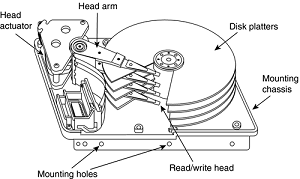Definition of a Hard Disk
To many users, the hard disk drive is the most important and yet the most mysterious part of a computer system. A hard disk drive is a sealed unit that a PC uses for nonvolatile data storage. Nonvolatile, or semi-permanent, storage means that the storage device retains the data even when no power is supplied to the computer.
Because the hard disk drive is expected to retain data until deliberately erased or overwritten, the hard drive is used to store crucial programming and data. As a result, when the hard disk fails, the consequences are usually very serious. To maintain, service, and upgrade a PC system properly, you must understand how the hard disk functions.

A hard disk drive contains rigid, disk-shaped platters, usually constructed of aluminum or glass. Unlike floppy disks, the platters can't bend or flex—hence the term hard disk. In most hard disk drives, you can't remove the platters, which is why they are sometimes called fixed disk drives.
Removable hard disk drives are also available. Sometimes this term refers to a device in which the entire drive unit (that is, the disk and the drive) is removable, but it is more commonly used to refer to cartridge drives, where the platters are contained in a removable cartridge.
Hard Drive Advancements
In 1957, Cyril Northcote Parkinson published his famous compilation of essays titled Parkinson's Law, which begins with the statement, "Work expands so as to fill the time available for its completion." A corollary of Parkinson's most famous "law" can be applied to hard drives: "Data expands so as to fill the space available for its storage."
This, of course, means that no matter how big a drive you get, you will find a way to fill it. I know that I have lived by that dictum since purchasing my first hard disk drive 20 years ago. Even though I am well aware of the exponential growth of everything associated with computers, I am still amazed at how large and fast modern drives have become.
The first hard drive I purchased in 1983 was a 10MB (that's 10 megabyte, not gigabyte) Miniscribe model 2012, which was a 5 1/4'' (platter) drive that was 203.2mmx146mmx82.6mm or 8''x5.75''x3.25'' (LxWxH) in overall size and weighed 2.5kg (5.5 lb., which is more than some laptop computers)!
By comparison, the 300GB Maxtor MaXLine II model 5A300J0 drive (currently the highest-capacity 3 1/2'' hard drive) uses smaller 3 1/2'' platters, is about 147mmx101.6mmx26.1mm or 5.8''x4''x1'' in overall size and weighs only 0.62kg (1.34 lb.). It stores a whopping 300GB, which is 30,000 times more storage in a package that is less than one-sixth the size and about one-fourth the weight. That's a pretty large step in 20 years' time!
To give you an idea of how far hard drives have come in the 20+ years they have been used in PCs, I've outlined some of the more profound changes in PC hard disk storage:
-
Maximum storage capacities have increased from the 5MB and 10MB 5 1/4'' full-height drives available in 1982 to 300GB or more for even smaller 3 1/2'' half-height drives (Maxtor MaXLine II) and 80GB or more for notebook system 2 1/2'' drives (Hitachi Travelstar 80GN) that are 12.5mm (or less) in height. Hard drives smaller than 30GB are rare in today's desktop personal computers.
-
Data transfer rates to and from the media (sustained transfer rates) have increased from between 85KBps and 102KBps for the original IBM XT in 1983 to an average of 62MBps or more for some of the fastest drives today (Seagate Cheetah X15.3).
-
Average seek times (how long it takes to move the heads to a particular cylinder) have decreased from more than 85ms (milliseconds) for the 10MB drives used by IBM in the 1983 vintage PC-XT to 3.6ms or less for some of the fastest drives today. The Maxtor Atlas 15K features an average seek time of just 3.2ms.
-
In 1982–1983, a 10MB drive and controller cost more than $2,000 ($200 per megabyte), which would be more than double that in today's dollars. Today, the cost of hard drives (with integrated controllers) has dropped to one eighth of a cent per megabyte or less, or about 80GB for $100!